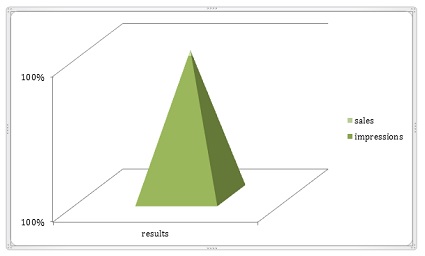Sometimes we can tell that clients who are shifting some of their spend from traditional or legacy media ads to digital or online ads feel disappointed about the numbers they see.
What kind of numbers do they see? A pay per click or cost per click campaign might show you that you’ve had
- 200,349 impressions
- 735 clicks
- 42 conversions
Then you can follow the conversions in your analytics, depending how you’ve configured it, and perhaps see that of those 42 who requested information, 15 actually bought.
Often, people who are accustomed to paying thousands of dollars for ads in other media feel disappointed by these numbers. They feel happier about their TV or newspaper ads.
The problem is not that digital ads are ineffective. The problem is that they’re measurable.
If I want to advertise in a physical newspaper for a city near where I live, I can pay $363.00 per black and white column inch, or $2,178 for a business card sized ad. I live in a fairly rural area, so I checked out bigger cities as well and saw prices more in the $11,000 range, but I know I could also find lower rates.
The price for digital ads can vary, too. You could pay $2,000 for 735 clicks, or $11,000, or less. So far, it’s about the same for digital and physical world ads.
That $11,000 ad was for a paper that claims a Sunday readership of 897,100. The $2,000 ad was for a paper claiming a readership of 171,446. For both of these, you’d be paying about a penny per person — which doesn’t sound bad at all.
If you pay $2,000 for those 200, 349 digital viewers, actually somewhat higher than the random example I took the numbers from, you’re paying a bit less than a penny per person.
Since you can specify the geographic area where you want your digital ads shown, our two examples are really quite similar so far. You’re paying about the same for the number of people who will be shown your ad, whether you put it in the paper or online.
You run your digital ad. Let’s say that you’re selling specialized medical wearables for diabetics. Your product is shown to over 200,000 people who are specifically looking for information about these items. More than 700 of the people who were shown your ad actually clicked through to get more information, and 42 followed up by sending in a contact form.
Your price point is around $400 and you sold 15 for your $2,000 investment, so you’ve made about $6,000; depending on your profit margin, this might be great news. Still, it looks like only a very small number of people are paying any attention to your ad!
Next week, you put that $2,000 into a newspaper ad. The paper has a circulation of almost 200,000 people and your ad is in a section on health.
Let’s follow that paper.
- 171,446 are delivered (well, 171,433, since that one delivery guy missed an apartment complex that day and a dog ran off with another paper on the other side of town).
- 167,863 are actually picked up and brought into the subscriber’s home. The rest are forgotten until the following week, when they’re thrown away unopened.
- 102,000 people open the health section, while the rest immediately toss it into recycling because they only wanted the headlines and the sports section.
- 57,198 look at more than one page of the health section, while the rest use it for the bottom of the birdcage, the cat box, or draining fried chicken, among other creative uses.
- 12,639 look at the page on which your ad is placed. Your ad is below the fold, though, so 8,456 of those readers fail to see it.
- 735 people actually read your ad. 8.3% (61) of them are diabetic.
- 15 of those people take action, perhaps by going to your website.
- Since your salespeople close about a third of their sales, 5 people buy your item.
5… 15… chances are, you aren’t tracking things well enough to see any significant difference between the newspaper ad and the digital ad — especially since most of the numbers are entirely imaginary. 8.3% of Americans are diabetic, but otherwise these numbers are guesses.
You don’t know how many people open their newspapers, how many open the specific section where your ad is, how many look at the page your ad is on, how many of those people have any interest in your device, or how many of your web visitors looked at the newspaper before they visited.
Newspaper ad salespeople can simply assure you that hundreds of thousands of people will see your ad and leave it at that.
They say ignorance is bliss. In this case, we disagree. It’s better to know that only people who are actually looking for your goods and services will be shown those goods and services. It’s better to know how many had the opportunity to see your ad and how many took the trouble to click through. It’s great to be able to compare different efforts on the basis not of how many people might conceivably have seen your ad but on the basis of how many leads and sales you received.
There are still areas of uncertainty. You don’t know how many people saw your ad and chose to click through on your organic results. You don’t know how many saw your ad and called you instead of clicking or how many saw your ad one day and then ruminated for a month, gathering information from other sources, before finally walking in to buy.
But the measurability of digital ads should be recognized as an advantage rather than being a source of dismay.


Leave a Reply